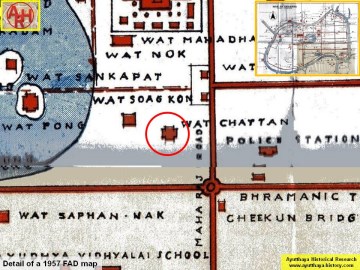| WAT CHATTHAN (วัดฉัตรทัน) |
| Wat Chatthan was situated on the city island in Pratu Chai sub-district. The monastery was situated on the west bank of Khlong Pratu Khao Pluak - Pratu Jin and in close vicinity of the Bhramin shrines and the Chikun Bridge. The name of the temple is derived from Chattban, or Chaddanta, a king of elephants, who, according to Siamese legends, lives in a golden palace on the shores of the Himalayan lake Chatthan (one of the seven lakes of Himaphan or Himalaya), attended by eighty thousand ordinary elephants. Burnouf applied the term Erawan or Airavana to a one-headed elephant, and considered the three-headed elephant to be Chatthan, which he identified as Chaddanta, the elephant of six defences or tusks. Erawan, the three-headed elephant of Indra is often represented on the gables of Thai temples. [1] The temple is mentioned in the Royal Chronicles of Ayutthaya. In December 1765 (January 1766) a heavy fire broke out on a late Friday night at Tha Sai (Sand Landing) and spread south along Khlong Pratu Khao Pluak via the Elephant Bridge (Saphan Chang) towards Wat Racha Burana and Wat Maha That to finally stop at Wat Chatthan. The Royal Chronicles mentioned that over ten thousand monastic structures and houses were destroyed. [2] When Saturday arrived, the fourth day of the waxing moon in the first month of the year of the dog, eighth of the decade, in the year 1128 of the Royal Era, late in the middle of the night, a fire broke out inside the Holy Metropolis. It started burning at Sand Landing, caught and spread on in to the Bridge of the Elephants and the Canal of Unhusked Rice, and then came in and ignited the Coconut Forest, the Thon Forest, the Charcoal Forest, the Flame Tree Forest, the Medicine Forest, the Monastery of the Royal Repairs and the Monastery of the Holy Glorious Grand Reliquary. The fire continued and only stopped at the Monastery of Chatthan. The dormitories, preaching halls, houses and homes which the fire ignited and burned on that occasion totaled over ten thousand buildings. Its historical background and period of construction are unknown. The site is indicated on a map drafted in the mid-19th century and on Phraya Boran Rachathanin's map drafted in 1926. Wat Chatthan was approximately situated in Geo Coord: 14° 21' 8.57" N, 100° 34' 6.52" E. References: [1] The Wheel of the Law - Alabaster Henry (1871) - page 295. [2] The Royal Chronicles of Ayutthaya - Richard D. Cushman (2006) - page 514 / Source: Phan Canthanumat, British Museum, Reverend Phonnarat & Royal Autograph. |


| Text & maps by Tricky Vandenberg - January 2010 Updated January 2011, April 2014 |
| (Detail of Phraya Boran Rachathanin's map - Anno 1926) |

| (Detail of a 19th century map - Courtesy Chao Sam Phraya Museum) |

| (Detail of a 1993 Fine Arts Department map - Courtesy Khun Supot Prommanot, Director of the 3th Regional Office of Fine Arts) |

| Addendum There are discrepancies between the 19th century map and Phraya Boran Rachathanin's map drafted in 1926 regarding the area west of Khlong Pratu Jin. On the oldest map Wat Chatthan is situated north of Talaeng Kaeng Street instead of south. Phraya Boran Rachathanin positions in this location the Place of the Deities or "Thewa Sathan". Wat Chatthan is here in a line with Wat Song Khon instead of Wat Saphan Nak. Wat Noi Nang Muk on the 19th century map is situated at the south-west corner created by Khlong Pratu Jin and Talaeng Kaeng Street (Chikun Bridge) in the location where Phraya Boran positions Wat Chatthan on his map. On a 1957 Fine Arts Department map we find Wat Chatthan in the position north of Talaeng Kaeng Street, opposite the old Police station, identical to the 19th century map. Wat Chatthan is not indicated on the 2007 Fine Arts Department GIS map, what lets presume that the site was never excavated. Bueng Phra Ram has been largely altered since the 19th century and especially its south-eastern corner where a large fountain has been constructed. The area has been completely reshaped and it will be today very hard to nearly impossible for archaeologists to determine the exact location of Wat Chatthan. References: [1] Tri Amatyakul - Guide to Ayudhya and Bang-Pa-In - Prachandra Press, Bangkok, 1957. |

| Addendum by Tricky Vandenberg - May 2014 |